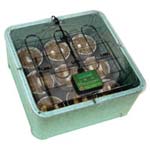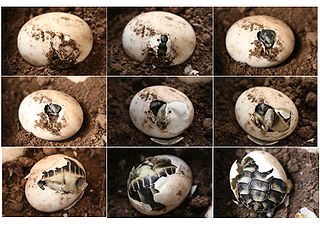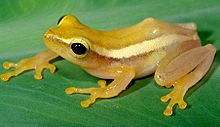Breeding reptiles is one of the most rewarding and enjoyable aspects of our hobby. It is quite important as well, as zoos have neither the time nor space to care for all the species that are, or will soon be, in need of help. Relatively common reptiles also deserve attention, as lessons learned about their reproductive biology are often applicable to rarer relatives.
 ZooMed’s reptile egg incubator, marketed as the Reptibator, utilizes heating technology that is a vast improvement over older (and very expensive!) incubators that I used while working at the Bronx and Staten Island Zoos. In addition to allowing for finer temperature and humidity control, the Reptibator’s Pulse Proportional Thermostat conserves energy while cutting electric bills.
ZooMed’s reptile egg incubator, marketed as the Reptibator, utilizes heating technology that is a vast improvement over older (and very expensive!) incubators that I used while working at the Bronx and Staten Island Zoos. In addition to allowing for finer temperature and humidity control, the Reptibator’s Pulse Proportional Thermostat conserves energy while cutting electric bills.
A Safer Thermostat
Pulse proportional technology uses short pulses of electricity to provide power as needed. Traditional “on-off” thermostats are an all-or-nothing proposition. Consequently, fluctuations in temperature and humidity often occur at the beginning and end of a heating cycle. I saw this very graphically when working with large commercial incubators in various zoos. At one point, a 24-hour monitoring system was instated on several such incubators after a series of hatching failures. Temperature fluctuations usually occurred just before and right after the heat came on.
The Reptibator’s Pulse Proportional Thermostat is a much safer alternative that provides even, steady heat and humidity throughout the incubation period.
Other Features
The Reptibator is economically priced and can hold 9 standard deli cups (which are commonly used as egg containers). The temperature range of 59-104 F has me wondering if the unit might also be used to provide the cooling-off period needed by many species prior to the breeding season (many need lower temperatures…please post below for details). I’ve used modified refrigerators for this purpose, and imagine the Reptibator would function just as well. Humidity can be set for 10-95%, a range that can accommodate the eggs of virtually any reptile, be it a desert or rainforest dweller.
Also included are internal water reservoirs, a built in memory function and an emergency alarm. The clear plastic cover allows one to check the contents without opening the incubator, thereby limiting disturbances to new hatchlings and temperature/humidity levels. The Reptibator is warranted for 12 months.
A video that clearly explains how to use this incubator is posted here.
General Incubation Notes
The moisture content of the incubation medium (sphagnum moss, pearlite etc.) is critical to hatching success. The Reptibator will limit fluctuations once the medium has been set up. Please see this article to read about a simple means of establishing the proper water to substrate ratio.
If you have 2 incubators or multiple clutches, you may be able to manipulate the hatchlings’ sexes. Please post below for further information.
When removing eggs from a terrarium, be sure to make a small pencil mark at the top of each, so that they are not accidentally rotated. Oils from the skin can clog air pores, so use powder free gloves or wash well before handling eggs (and after, of course!).
Phorid fly infestations (larvae can travel through egg air pores), mold, fungus and dystocia (egg retention) are among the problems commonly encountered by reptile breeders. Please see the linked articles and post below for further information.
 That Reptile Blog – Reptile, Amphibian and Exotic Pet Care and Information
That Reptile Blog – Reptile, Amphibian and Exotic Pet Care and Information





